Lisbon is one of the sunniest capitals in Europe, with over 300 sunny days a year. In the last few years, Portugal and, unsurprisingly, Lisbon, have become frequented holiday destinations. It’s truly an amazing city, and you can hit some exceptional regions and small villages nearby in under an hour. It’s also cost-friendly in many ways. With all this, you may be thinking of going to Lisbon this year for your holiday, and you may need a solid Lisbon travel guide to walk you through what you need to know. After all, it’s not easy to pick among hunderds of top things to do in Lisbon. From places to visit like Belém and Castelo de São Jorge to understanding the public transportation, solid day trips, activities like surfing or hiking, and planning your entire trip, this Lisbon travel guide will be filled with things you can plan your Lisbon travel itinerary around.
Check this article out, too: What to do in Cadiz, Spain? Your Travel Guide to Cadiz

Introduction to Lisbon and Preparation
Lisbon is not the kind of city you just show up to without a plan. You can wing it for sure, but you’ll realize that a little preparation with a solid Lisbon travel guide, you can create some killer Lisbon itinerary.. Some things to plan for are the weather, what activities you will do (yes, surfing!), where you will stay (whether you’re going to walk or take public transportation), what sights you are most interested in, and, of course, the food.
You need to plan your day around, especially with must-see spots like museums or historical sights. You have to go early in the morning or at hours when the lines are way shorter. Otherwise, you’ll actually spend your entire day in the queue. You will also need to plan for detours and schedule changes because you will change your schedule. You’ll see something on the road, and that thing will end up taking a big chunk of your day if not your whole day. These are things you should always keep in mind.
Best Time to Visit Lisbon and How Long to Stay
Lisbon has something to offer all year, and the weather is always impeccable. Keep in mind, though, that your experience can change a lot depending on the season. Spring, from March to May, is a sweet spot with mild weather, fewer crowds, and flowers blossoming. Autumn, from September to November, has warm days without the summer rush, a little breeze, and sweater nights. These days are perfect for wandering slowly and hitting all the famous spots without the rush. Also, both autumn and spring have way lower prices. They call these seasons “shoulder seasons.”
Summer is peak tourist season, with festivals, buzzing streets, and higher prices. If you can handle the heat and the crowds, it’s still an unforgettable time. The good thing about Lisbon is that the weather isn’t as bad as in inland Portugal or Spain. The ocean’s breeze is always there. Winter is quieter and cooler. Traditional winter events like Christmas Markets are way different in Lisbon.
How Long Should you Stay in Lisbon?
This depends a lot on your expectations. I stayed only a few days, and it wasn’t enough for me. For a quick break, the absolute minimum is three full days to get a feel for Lisbon. That covers the main neighborhoods, a couple of viewpoints, and some time to sit and people‑watch. Five to seven days is the sweet spot. In addition to seeing a lot of Lisbon, you can do quick day trips from Lisbon to places like Sintra or Cascais.
Lisbon’s Historic Neighborhoods
Unlike most of the big cities in Europe, one of the things that makes Lisbon stick out is that the entire city is filled with historic neighborhoods. They all have different vibes and histories and are must-sees. Essentially, Lisbon is a patchwork of neighborhoods. You can stay in one of these neighborhoods, but they are generally either hilly or have roads that are too small to walk on. I suggest staying somewhere different but still closer to them.
Alfama
Alfama is probably the most famous neighborhood in Lisbon. It’s also the oldest. It’s not the biggest area, but it’s got solid history, it’s in the middle of the city, and you can reach most of the must-see spots within here. One good thing about here is that you will find some of the nicest bars, houses, and viewpoints. The area is filled with tourism, though, and it’s got a lot of narrow streets and is quite hilly. Alfama should be your first destination.
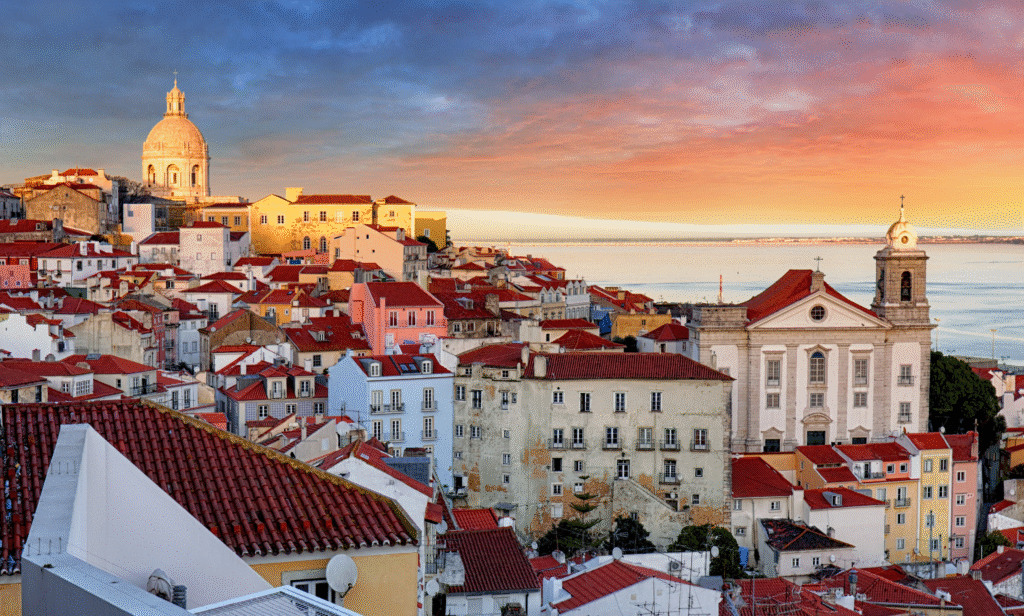
Baixa
Another “heart” of Lisbon. Yes, Lisbon has many hearts that pump blood to the city. Baixa was destroyed after the 1755 earthquake, and it was completely rebuilt after that. That’s why it’s got a different charm: newer and fresher. There are grand squares, straight boulevards, and a ton of shops, cafés, and bars. You will see more locals here than in Alfama.
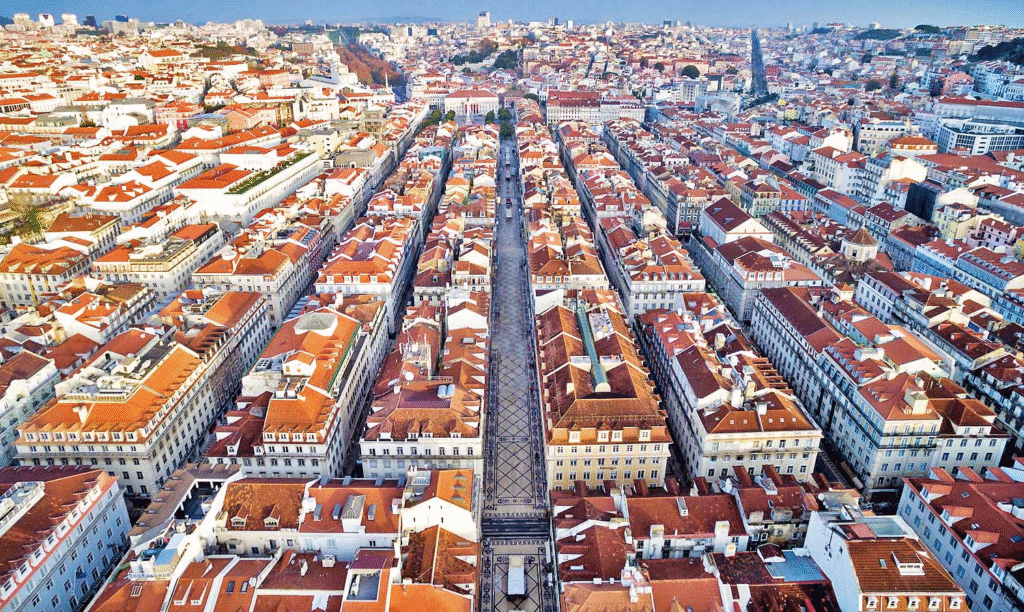
Chiado
A classy blend of old-world charm and modern style. Chiado is where you go for boutique shopping, historic cafés, and streets that feel made for slow strolling with a coffee in hand. Less touristy and less crowded.

Príncipe Real
Compared to the other neighborhoods I mentioned, this one is greener, leafier, and alive. The district has a lot of gardens you can cool down in and have a nice walk around. It’s not full of narrow streets, buildings, or stores touching each other in every corner. It has more shopping stores and has one of Lisbon’s oldest palaces from the 19th century.

Bairro Alto
By day, it’s a sleepy grid of streets. Not much different than the traditional Alfama. By night, it turns into Lisbon’s party hub. If you are looking for a night out, good cocktails, and music on every corner, you should go to Bairro Alto. Bairro is one of Lisbon’s oldest neighbourhoods, and the famous yellow trams going up and down the hills are also mostly here.
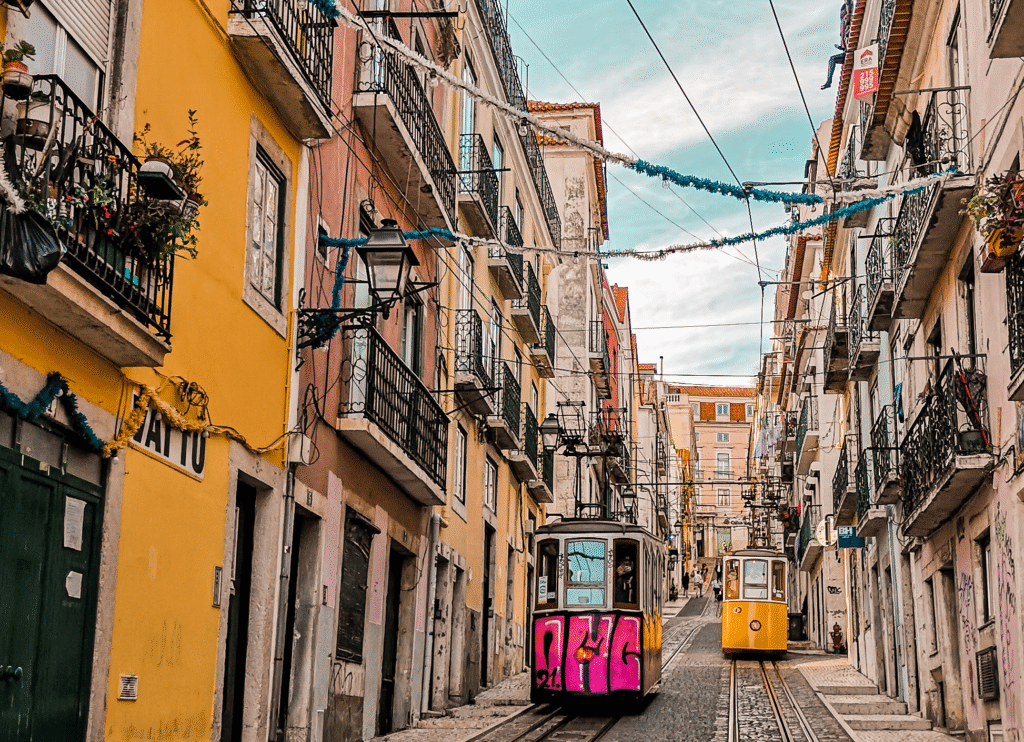
Free Things to do in Lisbon
One of the things I love about Lisbon is that it doesn’t make you empty your wallet to have a good time. In fact, some of the city’s best moments are free. Take the miradouros (viewpoints) as an example. They are epic around the hills, and they are almost exclusively free. You can grab picnic stuff, your wine, and whatever you want, and just sit at a viewpoint. Miradouro da Senhora do Monte and Miradouro de Santa Catarina are some of the good ones.
- Have a picnic at one of the beaches, grab your wine and snacks.
- Wander around the neighborhoods I just mentioned. You can grab a cup of coffee for 1 Euro or something and call it a day.
- On Sundays, many museums like the National Tile Museum have free entry for a few hours, so you can get your culture fix on the cheap.
- If you’re in town on a Tuesday or Saturday, explore Feira da Ladra, the city’s oldest flea market.
Must-See Attractions in Lisbon
Even though the neighborhoods, beaches, and the sun-soaked cafés’ terraces are really nice, Lisbon has some solid must-sees. Historical stuff or some stuff that’s just naturally in every Lisbon travel guide. Here are some of the highlights.
Belém Tower
Anyone says Lisbon, I say Belém. You will find this in almost every Lisbon travel guide, and it’s for a good reason. This 16th-century fortress sits by the Tagus River and is one of Lisbon’s most photographed landmarks. The tower was originally built to guard the harbor, but it now stands as a symbol of Portugal’s Age of Discovery. Climb to the top for sweeping river views. Also, Belém Tower is obviously a UNESCO World Heritage Site.
Jerónimos Monastery
Just a short walk from Belém Tower, this monastery is a masterpiece of Manueline architecture. It was built to honor Vasco da Gama’s voyage to India, and you can even see his tomb inside.
São Jorge Castle
Similar to the Belém tower, São Jorge Castle is another historical site at the top of the city with amazing views. It’s another magnificent place to get a good mix of history, scenery, and activity. Walk along the ancient walls, explore the towers, and see what life was like when this Castle was Lisbon’s main defense line.
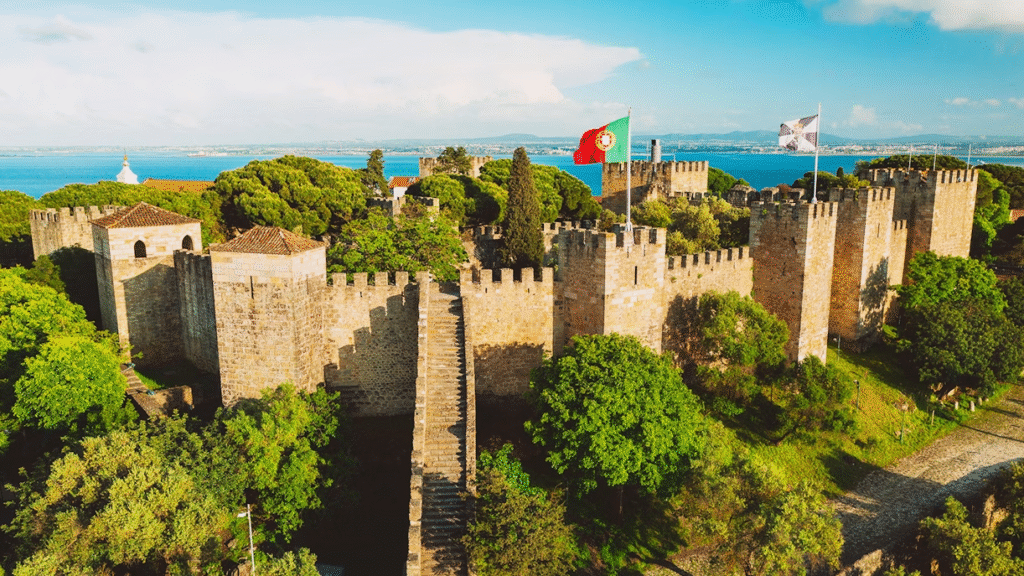
Praça do Comércio
Once the site of the Royal Palace, this grand square now serves as a hub for everyone in the city. It’s another prime spot for pictures right by the yellow arcaded buildings and the road opening onto the Tagus River. You can also do some nice riverside walks and sit at one of the cafés nearby. Great place to calm down and rest.
National Tile Museum
The National Tile Museum was founded in 1509, and it has collections from the 15th century to the present. It’s got every level of art in Portugal’s history. This museum is one of Portugal’s most important national museums, and it’s a must-see if art is your thing.
Lookouts, Parks, and Sunset Spots
This could’ve gone under “free things to do in Lisbon,” but I thought it deserves its own heading. Mainly because most Lisbon travel guide doesn’t do justice to Lisbon’s parks and lookouts. Especially some seriously good sunset spots. Lisbon is a green city; it’s full of parks, lookouts, and, of course, sunset spots (mainly beaches or by the ocean). There are some important places you can put in your list to get the best experience with these.
- Miradouro da Senhora do Monte: One of the highest viewpoints in Lisbon. It has a sweeping panorama of the city’s rooftops and the Castle. It’s quieter than most, perfect for an unhurried sunset.
- Miradouro de Santa Catarina: Known for its bohemian vibe, street performers, and chilled crowd. The view over the river is spectacular, especially during sunset.
- Parque Eduardo VII: A central green space with a symmetrical garden layout and views stretching toward the river. It’s great for a daytime stroll and an afternoon break.
- Jardim do Torel: A hidden gem with shaded benches and a peaceful atmosphere. From here, you can watch the sunset very well.
- Praça do Comércio Waterfront: Not a traditional park, but the broad riverside area is unbeatable for watching the sunset behind the bridge. Bring a drink and enjoy the atmosphere.
Tip: These places sit across different areas of the center, so weave one into each day. If you’re chasing sunset, pick a single spot and stay: the evening light changes fast, and the ambiance is half the fun.
Lisbon’s Nightlife: Drinks, Wine
Lisbon’s nightlife is amazing. What can you expect in a city by the ocean with great weather, culture, and amazing food and wine? The city is full of lively bars with live music, traditional taverns, and unique wine experiences. Whether you prefer sipping cocktails on a rooftop or enjoying a glass of local vinho verde in a historic neighborhood, the city has something.
- Bairro Alto Bars – The historic area is famous for its bars and nightlife once the sun sets. Narrow streets are lined with bars offering everything from cheap beers to craft cocktails.
- Time Out Market Wine Bar – A great spot to taste Portugal’s diverse wines in one place. You’ll be here during the day anyway, so time your visit for wine o’clock.
- Pensão Amor – This place was once a brothel. Now, it’s one of Lisbon’s quirkiest bars.
- Fado Houses in Alfama – While technically more about the music, the wine flows generously. Enjoy a cultural night with soulful songs and glasses of red or white.
- LX Factory Craft Breweries – Not all about wine. This creative hub has spots where you can enjoy Portuguese craft beer in an artsy, industrial setting.
Time Out Market
What kind of a Lisbon travel guide would this be if I didn’t write about Time Out Market? Any Lisbon travel guide will also have this. Time Out Market is quite a big market in the city center with all kinds of things – from cheese, meat, wine to fish, souvenirs, and sweets. You can grab a nice lunch and walk around to get some small snacks to try different stuff. It’s a bit expensive, though, so don’t get a lot of stuff, just to taste and some souvenirs.
Practical Essentials
Portugal, as a country, is a tourist destination. There are millions of people coming here every year. You will not have many problems with language, safety, and other minor things, but knowing how they work is always good. Especially with money, you should be prepared if you need cash or if you need to prepare your bank for it, and so on.
Language
If you stay in center Lisbon or in nearby popular towns like Ericeira or Combria, you will never have a problem with English. Most people in this city speak good English, so asking for help is easy. Still, try bom dia for morning and obrigado or obrigada when someone helps you. A few words go a long way.
Transportation: Public, Walking, Private
Generally, Lisbon is a walkable city. You will not have a problem getting around, but the biggest issue is that it’s hilly. I don’t recommend doing that on a summer day under the sun. It can get bad. Instead, use public transportation. It’s easy to use, practical, and can get you anywhere easily. Just get the green card from any public transportation machine and top that up. You can use that at any transport option. If you want, you can also use Uber or normal taxis, but they are unnecessary most of the time.
Money
You can pay by card almost everywhere. Cards work for restaurants, shops, and transit. Carry some euros for small stalls or markets because they don’t take cards.
Safety
Portugal is a safe country, and Lisbon is no exception to this. This city feels safe day and night, but keep your bag zipped on crowded trams and at viewpoints. Pick a calmer street to stay on if you prefer quiet at night.
Day Trips from Lisbon: Beaches, and On-the-Water Experiences
Another good thing about Lisbon is that you don’t have to be stuck in one city. There are a ton of nice little towns where you can take a day trip from Lisbon. You can go to these places for activities (like surfing), quick beach getaways, a history trip, or just a simple strolling day. Since Lisbon’s train and bus systems are pretty good and reliable, it will take you less than an hour, and it will be a comfortable ride.
Almost every Lisbon travel guide will also mention this, and each will have a different list of day trips from Lisbon. I will do my own – from my experiences!
Cascais
A stylish seaside town about 40 minutes from Lisbon by train, Cascais has sandy beaches, a lively marina, and a charming old town with restaurants and boutiques. Great day trip for a simple getaway to swim, bike, or sunbathe. The bike ride along the coastal path to Guincho Beach, a hotspot for surfers, is pretty nice. By car, it’s a quick 30-minute drive, and buses also connect Lisbon to Cascais, although trains are more scenic and easier.
Costa da Caparica
Just across the river, Costa da Caparica stretches for miles with golden sand and plenty of surf schools. It’s perfect for a beach day without going too far from the city. It’s also great if you are looking for a surf day without the crowds of Lisbon. You can reach it in about 25 minutes by car or bus. You can even take it in the afternoon.
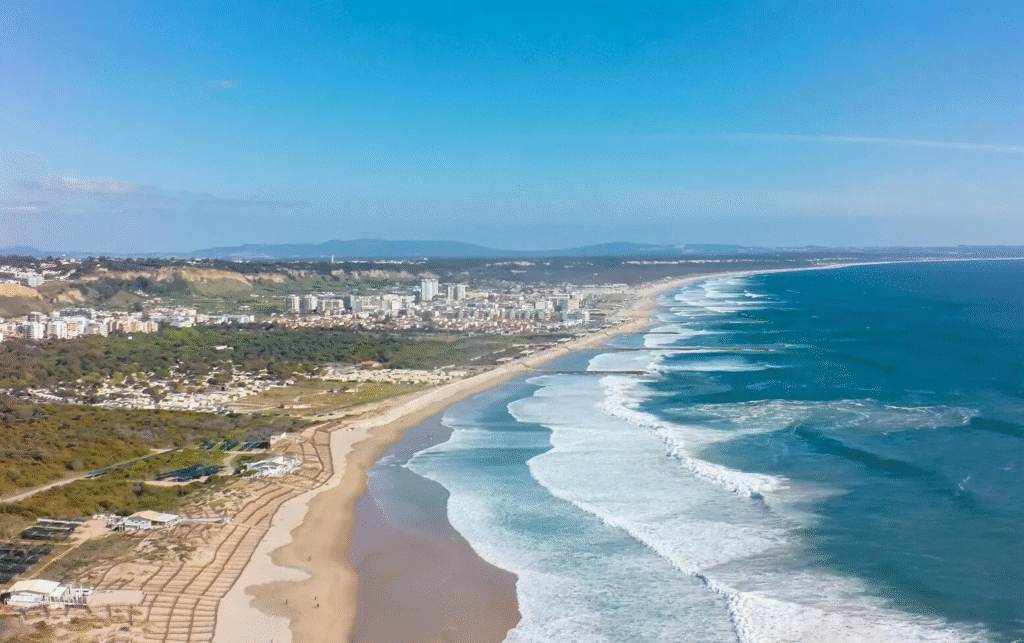
Sesimbra
Sesimbra is known for its calm waters and fresh seafood. It’s a great spot for kayaking, diving, or taking a boat tour. It’s about 40 minutes by car or just over an hour by bus from Lisbon. The surrounding Arrábida Natural Park is an extra little touch if you want to do hiking or be in nature.

Ericeira
I even wrote an entire article about Ericeira and its amazing surf culture. Here is Portugal’s surfing capital, a UNESCO World Surf Reserve and a must-visit for wave lovers. It’s Europe’s only World Surf Reserve. You will have a fantastic time on the water in Ericeira. Beyond the surf, Ericeira is a little town with cobbled streets and seafood restaurants. It’s roughly 50 minutes by car or about 90 minutes by bus from Lisbon. There isn’t much to see; you can see the city in half a day, but leave a day for picnics on its amazing beaches, evening walks, and surf.
Setúbal and Troia Peninsula
Setúbal is a bustling port city with easy access to the Troia Peninsula’s beaches. From Lisbon, it’s about 50 minutes by car or train, plus a short ferry to Troia. You can also take dolphin-watching cruises here, a different activity from surfing or kayaking.
Conclusion
A solid Lisbon travel guide can go on for pages, tens of thousands of words. I’ve tried to keep it solid and only the good stuff that I’ve experienced, and know myself. Obviously, it’s hard to put all of these in one Lisbon itinerary. You’ll have to make your picks and only go and do those things that you would like to do.
What I can say is that you will always find something to do, somewhere to go, and something to eat in Lisbon. You can stay for three days, a week, or even a few weeks. You can take a day trip from Lisbon every other day and still have places to go after a month.
FAQ
How long should I plan my Lisbon trip to see the main sights?
For a solid visit, plan 4–5 days. That gives you time for key monuments, a food market stop like Time Out Market, one beach or day trip, and some neighborhood wandering without rushing.
When is the best time of year to visit Lisbon to avoid lines and crowds?
Visit in shoulder seasons — April–June or September–October. You’ll enjoy milder weather, fewer queues at places like Belém Tower, and easier reservations at popular restaurants and rooftop bars.
Which neighborhoods are best if I want walkable streets and easy transit?
Pick central areas such as Chiado, Avenida da Liberdade, and Príncipe Real. They put you close to tram lines, metro stations, shops, and many top cafés for breakfast and brunch.
How do I get around Lisbon?
Use the metro for fast cross-city trips, Tram 28 for a scenic route (expect crowds), and Uber or Free Now for late nights or luggage. Scooters like Cooltra are great for short hops if you’re comfortable riding.
What sweet treats should I try in Lisbon?
Don’t miss pastéis — Pastéis de Belém has the tradition, while Manteigaria is a great alternative. For gelato, check out Nannarella or Gelato Davvero.
Are day trips to Sintra or Cascais worth it, and when should I go?
Yes — Sintra is magical but busy. Go early on a weekday to beat lines. Cascais and Costa da Caparica work well for a beach day; consider the train or a short drive, depending on your luggage and time.